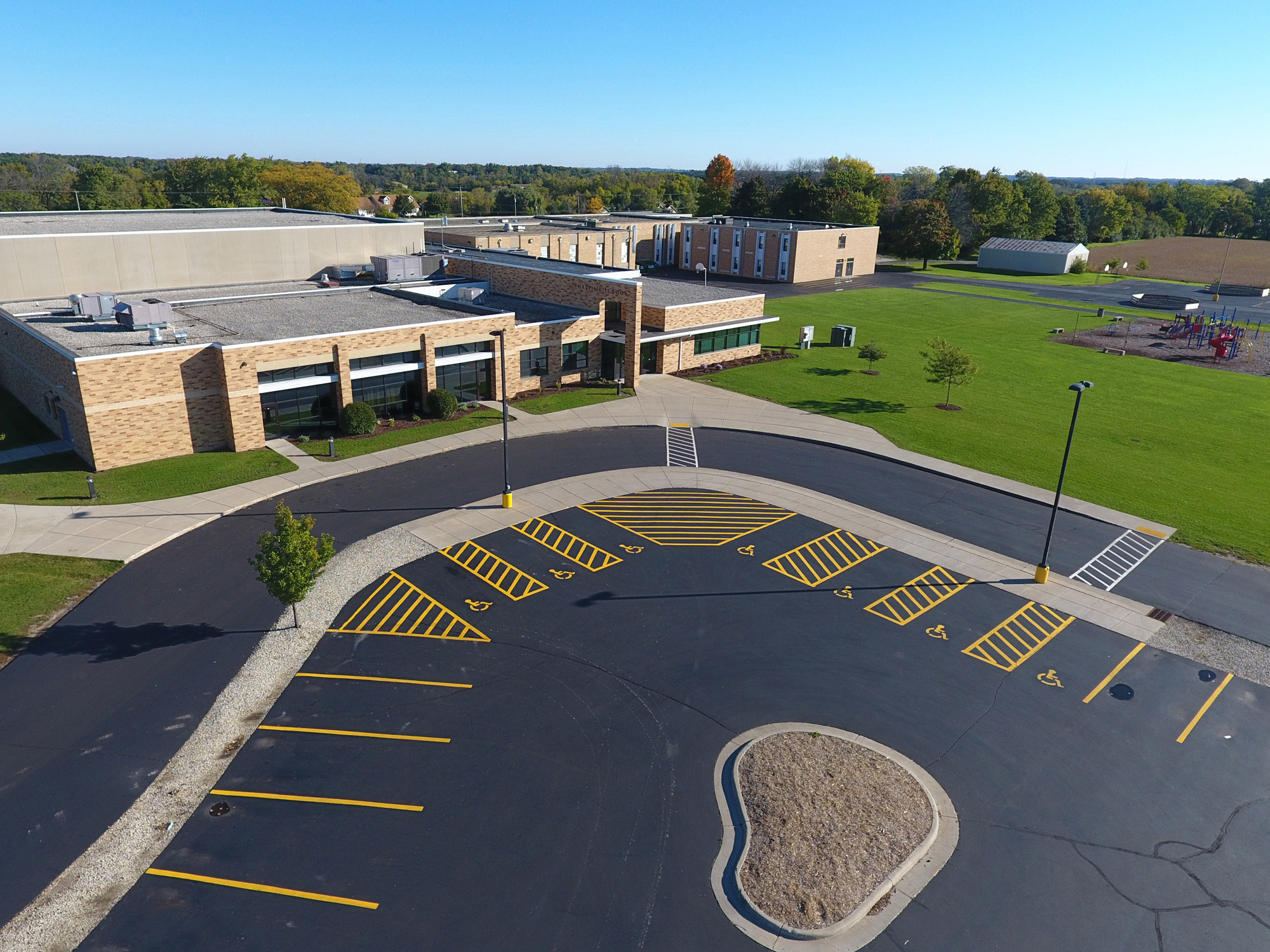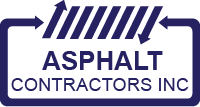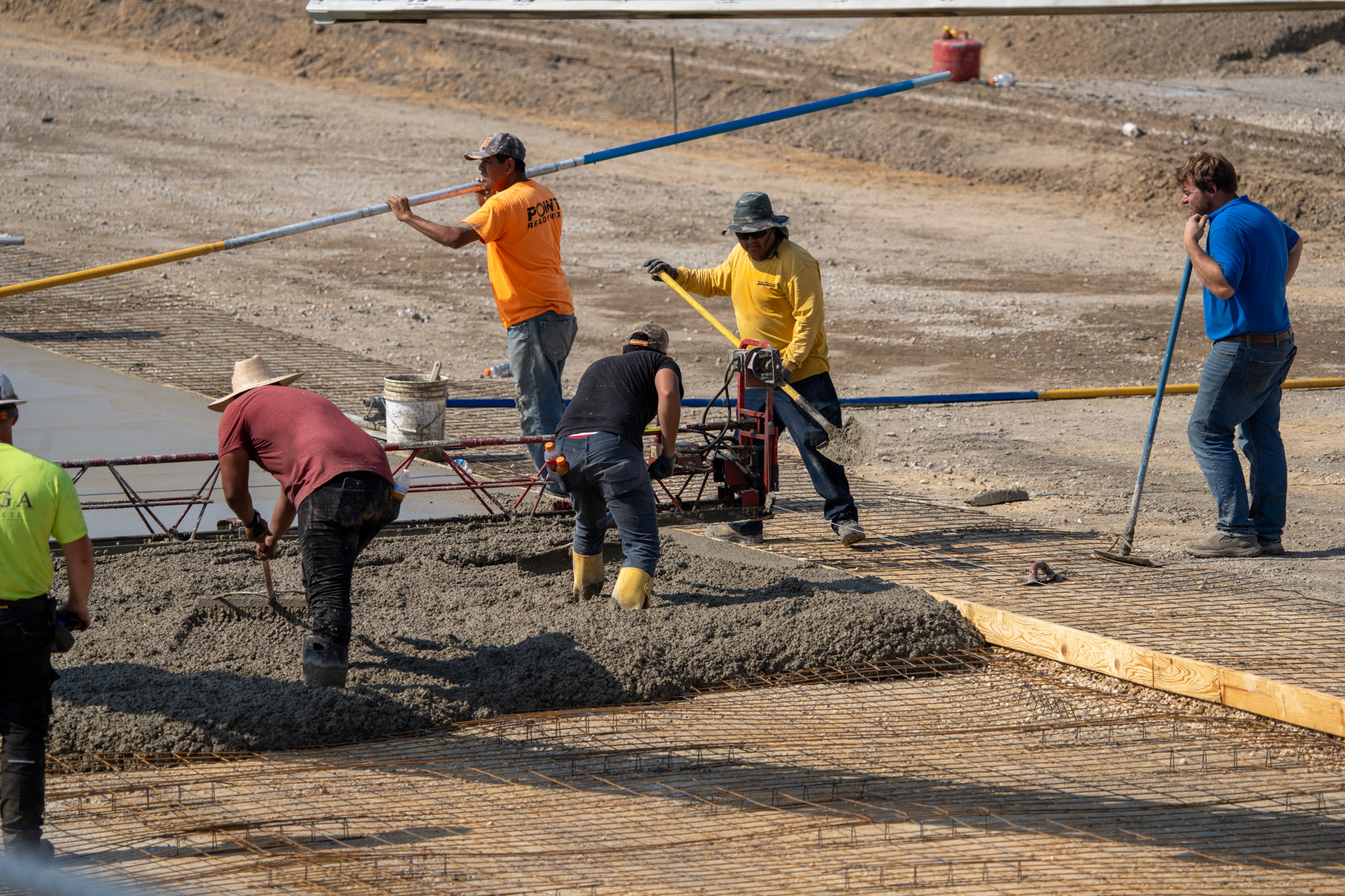Why timing your sealcoat matters for your parking lot

If you manage a commercial property, you know pavement maintenance is a balance of safety, appearance, and budget. The right sealcoating schedule can stretch the life of your pavement, but it is not always the right move. In this guide, we explain how often to sealcoat a parking lot and when skipping it can actually save money. We also break down asphalt vs concrete maintenance so you can plan smarter and avoid wasted spend.
Asphalt Contractors Inc., based in Union Grove, Wisconsin, has been helping businesses maintain asphalt and concrete surfaces since 1979. We manufacture our own asphalt, use proven materials, and bring certified crews to every project across Racine, Kenosha, Walworth, Waukesha, and Milwaukee counties. The best sealcoat timing depends on traffic, climate, and pavement condition. Use this guide to set the right schedule for your lot.
What sealcoating does and what it does not
What sealcoating does
Sealcoating is a protective topcoat for asphalt. It shields the surface from UV rays, water, salts, and vehicle fluids. A quality sealcoat restores rich black color, improves curb appeal, makes future cleanings easier, and slows oxidation that leads to raveling and cracking. When applied at the right time, it lowers life-cycle costs by protecting the asphalt binder and fines near the surface.
What sealcoating does not do
Sealcoating is not a structural repair. It will not fix base failures, deep potholes, or large alligator cracks. It is also not resurfacing. If your lot has advanced damage, an overlay or reconstruction may be the better investment. Sealcoating works best when combined with crack sealing, patching, and good drainage.
How often to sealcoat a parking lot
General rule of thumb
For most commercial asphalt parking lots, plan your first sealcoat 9 to 12 months after paving. This allows the asphalt to cure, letting light oils evaporate so the coating can bond. After the first application, seal every 2 to 3 years based on traffic and climate. Some high-traffic or high-sun areas may benefit from a 18 to 24 month cycle. Light-use lots may stretch to 3 to 4 years if the surface is still dark and tight.
Schedule by traffic level
- Light traffic, such as small offices or churches: First seal at 9 to 12 months, then every 3 to 4 years if the surface remains in good shape.
- Moderate traffic, such as retail centers and medical offices: First seal at 9 to 12 months, then every 2 to 3 years.
- Heavy traffic, such as busy plazas, industrial sites, or delivery hubs: First seal at 9 to 12 months, then every 18 to 24 months with frequent crack sealing and patching.
Climate and seasonal impacts in Southeast Wisconsin
Our region sees freeze-thaw cycles, snowplows, and deicers. These speed up pavement wear. UV exposure in summer and salts in winter both attack the binder. For Wisconsin properties, Asphalt Contractors recommends a tighter inspection schedule each spring. Many clients seal in late spring or early summer for the best cure window and to protect against the next winter. In shaded lots or areas with poor drainage, consider earlier interventions because trapped moisture can worsen surface damage.
Material, layout, and use patterns
Not all asphalt behaves the same. Mix design, thickness, and base strength matter. Lots with tight turning movements near entrances, trash enclosures, or loading zones wear faster and may need spot sealing and more frequent crack sealing between full sealcoat cycles. Drainage also matters. Standing water accelerates stripping and raveling, so fixing grade and gutter issues can extend the time between coatings. If Asphalt Contractors paved your lot, we can review the original mix and thickness to set a maintenance plan tailored to your pavement’s profile.
Budget phasing without losing protection
If you manage many properties or large campuses, phasing can keep budgets even. Segment the lot into zones and seal on a rolling schedule. High-wear sections get more frequent attention. Low-wear areas can be sealed less often. This approach keeps traffic flowing and spreads cost without sacrificing performance.
When skipping sealcoating makes sense
The asphalt is too new and not fully cured
Fresh asphalt needs time to cure. If you seal too soon, the coating may not bond or can track. The surface should be firm, free of oily sheen, and pass a water bead test. As a general guideline, wait 9 to 12 months after paving for commercial lots. In cooler seasons, cure can take longer.
There is structural damage that needs repair first
If your lot shows deep alligator cracking, base pumping, wheel-path depressions, or widespread potholes, sealcoating alone will not help. In these cases, money is better spent on patching, milling and overlay, or full-depth reclamation. Sealcoating after structural repairs is a smart finish, but applying it before repairs is wasted spend.
Oil-saturated areas or heavy contamination
Excessive oil, fuel, or hydraulic leaks can weaken bond strength. While spot priming can improve adhesion, some saturated areas should be cut out and patched before sealing. Skipping sealcoating until contamination is addressed avoids early failure and tracking.
You have concrete, not asphalt
Sealcoating is designed for asphalt. Concrete requires different treatments, such as penetrating silane or siloxane sealers, joint sealing, and periodic surface cleaning. If your lot is concrete, do not apply asphalt-based sealcoat. You will waste money and create adhesion problems. In the asphalt vs concrete discussion, maintenance products differ. Always match the treatment to the material.
You plan major changes soon
If you will mill and overlay, add islands, resurface, or re-stripe with a new layout within the next season, skip sealcoating now and group the work. This avoids double-paying for traffic control and line striping.
Weather windows are not right
Sealcoating needs the right weather, typically daytime temperatures above 50 degrees Fahrenheit and rising, with no rain in the forecast and low overnight humidity. If the window is too tight, wait. Rushed applications in poor weather often fail, costing more in rework.
High-performance coatings are already in place
Some lots use specialty polymer-modified coatings with longer life. If your existing coating is outperforming standard timelines, periodic crack sealing and cleaning may be enough this cycle. Asphalt Contractors can assess the coating type and advise on the best timing.
Asphalt vs concrete: how maintenance actually differs
Surface sealing needs
In the asphalt vs concrete comparison, asphalt benefits most from routine sealcoating because its binder is organic and vulnerable to UV and oxygen. Concrete does not oxidize the same way. Concrete maintenance focuses on joint sealing, crack repair, spall patching, and penetrating sealers that reduce water and chloride absorption. Asphalt uses coal tar or asphalt emulsion-based sealcoats that form a protective film on top. Concrete uses penetrating chemistry that reacts within the pores.
Life-cycle cost in cold climates
Cold regions put both materials under stress. Asphalt is flexible and handles freeze-thaw cycles well, especially with a strong base and good drainage. Concrete can carry heavy loads, but deicing salts can attack the surface over time without proper sealing. With consistent maintenance, asphalt often offers a lower life-cycle cost for parking lots in Wisconsin because resurfacing options are less disruptive and more economical than major concrete repairs. That said, each site is unique. Asphalt Contractors can price both options and map a maintenance forecast for each.
Snow removal and deicers
Snowplows can scuff both surfaces, but they tend to scuff asphalt sealcoats more frequently if blades are not set correctly. Always use proper plow shoes and avoid sharp turns with bare blades. For concrete, avoid certain calcium chloride blends that can accelerate scaling. For asphalt, rinse accumulated salts in spring to reduce surface wear. Good winter practices stretch time between sealcoat applications.
Clear signs your lot is due now
- Color fading to light gray rather than dark charcoal
- Raveling where fine stones loosen from the surface
- Widespread hairline cracks forming a dry, brittle look
- Water no longer beads on the surface but soaks in quickly
- Traffic patterns appear as light streaks or polishing
- More oil stains that do not clean up well
If you see these signs, schedule an evaluation. Catching issues early reduces cost and extends pavement life.
What a smart sealcoating plan looks like
- Assess: Walk the site and mark cracks, oil spots, drainage issues, high-wear areas, and trip hazards.
- Repair: Complete crack sealing, patching, and small mill-and-pave areas first. Fix drainage problems when possible.
- Prep: Clean thoroughly with blowers and brooms. Treat oil spots with primer. Barricade properly for full cure time.
- Apply: Use the right mix design and sand load for your traffic level. Two coats on drive lanes and high-traffic areas are common.
- Stripe: Refresh lines, symbols, ADA markings, and wheel stops. Consider layout tweaks to reduce tight turns.
- Maintain: Inspect each spring. Address new cracks, spot seal high-wear areas, and plan your next full coat.
Budgeting and ROI
Sealcoating an average commercial lot typically costs a fraction of resurfacing. While pricing varies by size, layout, and prep work, a proper sealcoat can delay overlay by years. The return comes from slower oxidation, fewer cracks, reduced patching, and better curb appeal that supports tenant satisfaction. The key is timing. Seal too often and you waste money. Seal too late and you lose the protective benefit. Asphalt Contractors helps clients right-size their schedules based on condition and use, not a fixed calendar.
Common mistakes to avoid
- Sealing over dirty or wet surfaces that block adhesion
- Ignoring cracks before sealing, which lets water reach the base
- Applying in cold or damp weather that prevents proper cure
- Skipping prep on oil spots that cause peeling
- Using the same schedule for every property regardless of traffic and climate
- Sealing concrete with asphalt products
How Asphalt Contractors builds long-lasting results
Proven materials and in-house manufacturing
Because Asphalt Contractors manufactures asphalt in-house, we control quality from the plant to the pavement. This consistency matters when we patch, resurface, and then seal. Our certified crews select the right sealer and sand blend for your use conditions, whether light retail or heavy industrial.
Experienced project planning
Since 1979 our team has delivered paving, maintenance, milling and pulverizing, concrete work, site preparation, specialty services, and crushing. We phase work to minimize downtime, coordinate with tenants, and meet tight windows between seasons. Our equipment is maintained to high standards so we can finish on time and on budget.
Local expertise in Southeast Wisconsin
We know how Racine, Kenosha, Walworth, Waukesha, and Milwaukee counties wear on pavement. Freeze-thaw, salts, and plows are part of our planning. We recommend sealcoat timing that fits local weather, not generic national timelines.
Asphalt vs concrete: which is right for your property
Choosing between asphalt vs concrete depends on load requirements, budget, appearance goals, and maintenance plans. Asphalt offers quick installation, smooth black finish, and cost-effective resurfacing. It pairs well with a disciplined sealcoating and crack sealing program. Concrete can carry very heavy point loads and may suit small delivery aprons or dumpster pads. It uses different sealers and joint maintenance. Many properties use both materials. Asphalt Contractors can design hybrid solutions that place each material where it performs best and then set maintenance schedules that match.
FAQs about sealcoating frequency
How long does sealcoating last
In Wisconsin, a well-applied sealcoat typically lasts 2 to 3 years under moderate traffic. Heavy traffic, aggressive turns, or frequent snowplow use can shorten this. Light-use lots may go up to 4 years if the surface stays tight and dark.
When is the best season to seal
Late spring through early fall. Aim for warm, dry days with mild nights. Avoid rain within 24 hours before and after application when possible. Your estimator will schedule based on the forecast.
Can I seal every year
It is usually not necessary and can lead to buildup, tracking, or peeling. Yearly sealing is often overkill unless you have very heavy traffic or special conditions. Focus on crack sealing and spot repairs annually, with full sealcoats on the recommended cadence.
How soon can we drive on it
Most lots reopen within 24 to 48 hours depending on temperature, humidity, and sun. Heavier sections or shaded areas may need a bit longer. We will set barricades and timing to fit your business hours.
Will sealcoating fix cracks
No. Cracks must be cleaned and sealed with hot rubberized crack sealer before sealcoating. This prevents water intrusion and supports the sealcoat’s performance.
Plan your next sealcoat with Asphalt Contractors
A tailored plan protects your pavement and your budget. Asphalt Contractors Inc. will inspect your lot, rate its condition, and recommend the right timing. If skipping this cycle makes sense, we will say so. If repairs are needed first, we can handle patching, milling and overlay, concrete work, site preparation, and restriping. Our in-house asphalt manufacturing and experienced crews deliver consistent quality across Southeast Wisconsin.
Ready to set the right schedule for your property Contact Asphalt Contractors in Union Grove to request a site visit and a clear, phased maintenance plan. Protect your investment, improve curb appeal, and avoid unnecessary costs with a sealcoating strategy that works for your traffic, your climate, and your calendar.


